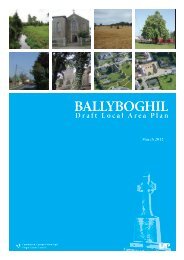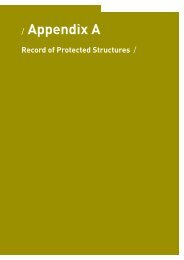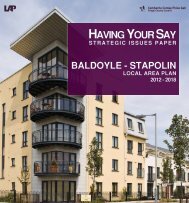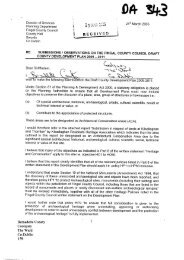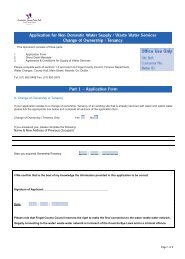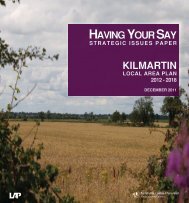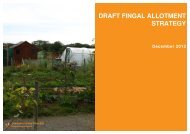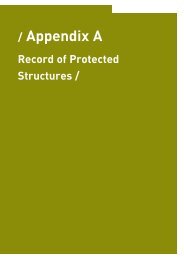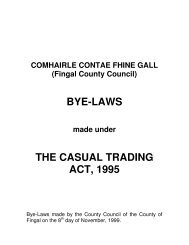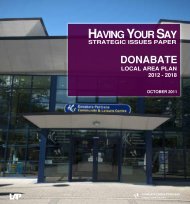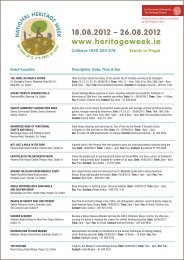Donabate Urban Centre Strategy Fingal County Council
Donabate Urban Centre Strategy Fingal County Council
Donabate Urban Centre Strategy Fingal County Council
You also want an ePaper? Increase the reach of your titles
YUMPU automatically turns print PDFs into web optimized ePapers that Google loves.
4.0 Character Assessment<br />
4.1.2 Adjacent to the Train Station<br />
The area adjacent to the train station is composed of a number of<br />
vernacular and standalone buildings dating from the early to late 19th<br />
century. On the southern side of Main Street plot widths range on<br />
average from 6m to 24m with plot depths ranging from 14m to 24m<br />
in width. On the northern side the plot widths and depths remain<br />
consistent with widths on average 30m and depths ranging between<br />
46-56m.<br />
The Railway Station with associated parking and infrastructure<br />
is located immediately east of the rail line and creates a high level<br />
of public activity. Space about the railway buildings is dominated by<br />
parking and vehicular movement resulting in a poor public realm with<br />
pedestrian access to the train station being restricted. Currently there<br />
is inadequate car parking capacity at the train station.<br />
Within the <strong>County</strong> Development Plan, Protected Structures of note<br />
within this character area include the following:<br />
RPS No Name<br />
509 Smyth's Public House<br />
510 Station Master's House<br />
511 <strong>Donabate</strong> Railway Station (Railway Station,<br />
Signal Box & Pedestrian Bridge )<br />
Buildings and structures of particular interest in the area include the<br />
Railway Station and Smyth’s Public House.<br />
The Railway Station consists of a detached two-bay two-storey red<br />
brick station master’s house built c.1890. The roof is double-pitched<br />
consisting of slate, terracotta roof ridge tiles, red brick chimney stacks,<br />
yellow clay pots and cast-iron gutters. The walls are red brick laid in<br />
Flemish bond.The openings are square headed with red brick quoining<br />
surrounds, limestone cills with uPVC casement windows.<br />
Smyth’s pub is a detached six-bay two-storey former house built<br />
c.1840. The roof consists of slate with terracotta ridge tiles and newly<br />
rendered chimney stacks and clay pots . The walls are random rubble<br />
with unusual round ended quoining to the left of the front elevation.<br />
The openings are square-headed with granite cills supported on granite<br />
corbels. Associated with its curtilage are a number of outbuildings, the<br />
most prominent of which is a two storey stone mill building worthy of<br />
retention and reuse. Some significant trees on the site reinforce the<br />
sense of enclosure in the area.<br />
View of Smyth’s Pub View of the Railway Station<br />
4.1.3 Adjacent to Newbridge Demesne<br />
This character area is located to the south west of town centre. Part of<br />
this character area is located within a designated ACA for Newbridge<br />
Demesne in the <strong>County</strong> Development Plan. The area is dominated by<br />
grassland, hedgerow and significant tree groups within which consists a<br />
number of protected structures and single buildings. The spaciousness<br />
and landscaping of the plots, as well as the large scale and architectural<br />
quality of the buildings and their spatial separation creates a unique<br />
character within this transitionary area, between the town centre and<br />
the Demesne. There exists a pedestrian way into Newbridge Demesne<br />
which is an important link to be maintained and enhanced.<br />
Within the <strong>County</strong> Development Plan, Protected Structures of note<br />
within this character area include the following:<br />
RPS No Name<br />
495 Former Lodge to Newbridge House<br />
506 The Cottage<br />
507 Waterpump<br />
508 St. Patrick's (Church of Ireland)<br />
Buildings of particular interest in the area include 'The Cottage' and<br />
St. Patrick's (Church of Ireland) Church, which are accessed off 'The<br />
Square'.<br />
‘The Cottage’ is a detached five-bay two-storey house built c.1840,with<br />
projecting entrance porch. The roof is double-pitched with terracotta<br />
ridge tiles and brick stacks with clay pots. The walls are pebble-dashed<br />
with square headed openings with rendered reveals and granite cills.<br />
Timber sash windows; timber casements; timber tongue and grooved<br />
front door with glazed overlight complete this attractive vernacular<br />
composition.<br />
Saint Patrick’s (Church of Ireland) Church is a detached church built<br />
c.1775, with a gable-fronted projecting entrance porch to the south<br />
elevation. A pre-1700 rubble stone square profile tower is situated<br />
to the north elevation. The roof is double-pitched consisting of slate<br />
and terracotta ridge tiles with cast-iron rainwater goods. The walls are<br />
rough-cast render with random rubble walls to the tower element. The<br />
openings are round-headed with rendered reveals and granite cills.<br />
Other buildings of note include a single-storey former thatched<br />
cottage and a detached three-bay two-storey house to the north of<br />
Turvey Avenue and a detached three-bay two-storey former vicarage<br />
with gabled dormers to the south of Turvey Avenue. Please refer to<br />
Map 4: <strong>Urban</strong> Design Appraisal.<br />
<strong>Donabate</strong> <strong>Urban</strong> <strong>Centre</strong> <strong>Strategy</strong> 11




